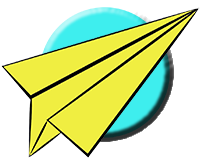How to Make a Catfish Paper Airplane
How to Make a Catfish Paper Airplane
Instructions
This true Delta Flyer needs medium to heavy weight paper. Start with a letter size sheet.
1. Fold the paper exactly in half along its short edge. Unfold after the crease has been made.
2. Fold the upper right corner down so the upper right point hits the center line crease at the bottom edge of the paper.
3. Unfold after the crease has been made.
4. Fold the upper left corner down so the upper left point hits the center line crease at the bottom edge of the paper. Unfold after the crease has been made.
5. Flip the paper over keeping the previously created creases at the top.
6. Fold the top edge down so the top point hits the center line crease at the point formed in the middle of the paper by the diagonal creases. Be sure the new crease is parallel with the top edge of the paper.
7. Unfold after the crease has been made.
8. Flip the paper over keeping the previously created creases at the top.
9. Make a crease to fold the upper right corner down. The left point of the new crease should be where the existing diagonal crease hits the left top edge of the paper. The crease must also go through the point formed by the existing horizontal and vertical creases near the top edge.
10. Unfold after the crease has been made.
11. Make a crease to fold the upper left corner down. The right point of the new crease should be where the existing diagonal crease hits the right top edge of the paper. The crease must also go through the point formed by the existing horizontal and vertical creases near the top.
12. Unfold after the crease has been made.
13. Pop the left and right points formed by the horizontal crease at the edges of the paper up, bringing them in and down. Bring the upper left and right corners back while bringing the top center point down toward the center line crease.
14. Flip the paper over keeping the tip of the nose up.
15. Fold the tip of the nose down so the top point hits the center line crease. The new crease should go through the point on the center line crease formed by the existing diagonal creases.
16. Unfold the crease just made.
17. Flip the paper over and rotate it around so the nose points up and to the right.
18. Fold the upper left and right corners down about the existing diagonal creases.
19. Rotate the plane around so the nose points down and to the right.
20. Make a crease to fold the lower left diagonal edge in. When folded correctly, the diagonal edge should line up with the base of the nose section coming out of the base of the paper. The right point of the new crease should be at the tip of the nose.
21. Do the same on the right by making a crease to fold the lower right diagonal edge in. When folded correctly, the diagonal edge should line up with the base of the nose section coming out of the base of the paper. The left point of the new crease should be at the tip of the nose.
22. Squash the nose section, sticking up from the base of the plane, down, so the top point comes to hit the center line crease. Two new creases are created on the left and right side of the nose as the fold is pressed flat.
23. Fold the tip of the nose over so the top point hits the center line crease where the nose flap overlaps the base of the plane.
26. Rotate the plane around so the nose points to the left.
27. Make a crease for the first wing flap. The left point of the new crease should be about one finger width up from the bottom edge of the fuselage and the right point should be about two finger widths up from the bottom edge.
28. Flip the plane over so the first wing flap is underneath.
29. Make a crease for the second wing flap. Be sure to line up the wing flaps for good balance.
30. Open up the wing flaps and adjust the dihedral wing angles so they are even. Set the dihedral angle flat to slightly upward. Add up the elevator by curling up the tail ends of the wings to balance the heavy nose section.
THE THROW Launch with a gentle, level throw or at a slight up angle. The addition of a piece of tape to hold the sides together adds stability to the flight. Taping up the drooping wing flaps on the underside decreases drag and increases flight distance.
